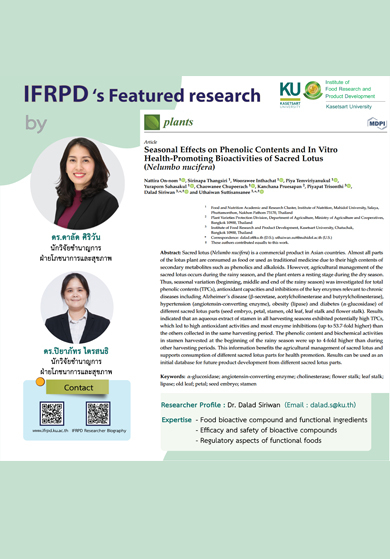Seasonal Effects on Phenolic Contents and In Vitro Health-Promoting Bioactivities of Sacred Lotus (Nelumbo nucifera)
| ผลงานวิจัย |
ดร.ดาลัด ศิริวัน และคณะ |
| Keywords |
α-glucosidase; angiotensin-converting enzyme; cholinesterase; flower stalk; leaf stalk; lipase; old leaf; petal; seed embryo; stamen |
| Telephone |
0 2942 8629 (1823) |
| Email |
dalad.s@ku.th |
| URL |
https://doi.org/10.3390/plants12071441
|
จุดเด่นผลงาน
บทสรุป : เป็นการศึกษาผลของฤดูการการเก็บเกี่ยวของบัวหลวงที่มีต่อปริมาณสารสำคัญและฤทธิ์ทางชีวภาพต่าง ๆ เช่น ฤทธิ์ยับยั้งอัลไซเมอร์ ฤทธ์ยับยั้งโรคเบาหวานและไขมันในเลือดสูง ข้อมูลนี้เป็นประโยชน์ต่อการจัดการด้านการเกษตรของบัวหลวงและสนับสนุนการบริโภคส่วนต่าง ๆ ของบัวหลวง เพื่อส่งเสริมสุขภาพ ผลลัพธ์สามารถใช้เป็นฐานข้อมูลเริ่มต้นสำหรับการพัฒนาผลิตภัณฑ์จากส่วนต่าง ๆ ของบัวหลวงในอนาคต
Abstract : Sacred lotus (Nelumbo nucifera) is a commercial product in Asian countries. Almost all parts of the lotus plant are consumed as food or used as traditional medicine due to their high contents of secondary metabolites such as phenolics and alkaloids. However, agricultural management of the sacred lotus occurs during the rainy season, and the plant enters a resting stage during the dry season. Thus, seasonal variation (beginning, middle and end of the rainy season) was investigated for total phenolic contents (TPCs), antioxidant capacities and inhibitions of the key enzymes relevant to chronic diseases including Alzheimer’s disease (β-secretase, acetylcholinesterase and butyrylcholinesterase), hypertension (angiotensin-converting enzyme), obesity (lipase) and diabetes (α-glucosidase) of different sacred lotus parts (seed embryo, petal, stamen, old leaf, leaf stalk and flower stalk). Results indicated that an aqueous extract of stamen in all harvesting seasons exhibited potentially high TPCs, which led to high antioxidant activities and most enzyme inhibitions (up to 53.7-fold higher) than the others collected in the same harvesting period. The phenolic content and biochemical activities in stamen harvested at the beginning of the rainy season were up to 4-fold higher than during other harvesting periods. This information benefits the agricultural management of sacred lotus and supports consumption of different sacred lotus parts for health promotion. Results can be used as an initial database for future product development from different sacred lotus parts.
Plants 2023, 12(7), 1441




